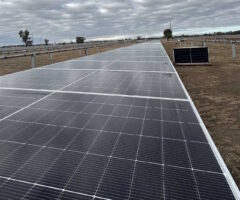First Solar’s new solar PV efficiency record went largely un-noticed in the local media last week, but it represents a major step forward for the march towards price parity for solar technology.
The US-based First Solar announced at the World Future Energy Summit in Abu Dhabi that it had set a new record for thin film solar products, achieving a module efficiency of 14.4 per cent, up from its previous record of 13.4 per cent.
The record, which has been verified by the US Renewable Energy Laboratory, and was established in a commercial setting rather than just a test lab, takes First Solar closer to its interim goal of 15 per cent module efficiency, which it sees as key to taking its costs down to around 10c-14c/kWh by 2015, where it expects to be able to compete with other technologies without subsidies.
First Solar is building Australia’s first utility scale solar PV project near Geraldton, a 10MW facility featuring its cadmium telluride thin film panels that is expected to be completed mid-year.
Jack Curtis, the company’s head of operations in Australia, says First Solar’s average module efficiency at the end of 2011 was 11.7 per cent, and was expected to rise to 12.7 per cent by the end of 2012.
The increased efficiency allows it to put more watts on the same panel and surface area, lowering the cost per watt, and reduces manufacturing costs. First Solar estimates that its cost per in the US are around 16-18/kWh, around 18c-20c/kWh in WA, and 20c-22c/kWh on Australia’s east coast, where the solar resource is slightly inferior.
To get the cost down to 10c-14c, requires an installed price of $1.40 to $1.60 a watt, from current levels of around $2.30-$2.50/watt. That means not just a cut in the manufacturing cost of panels below its current level of 70c/watt, but also a halving in the installation cost which accounts for the balance.
Curtis said this element was often poorly understood. Many argued against the early deployment of solar technologies on the basis that the country should wait for manufacturing costs to fall further. But more than half the cost of an installed panel came from local know how, infrastructure and financing – the cost of which would fall significantly as more solar PV was installed. “There is a tangible benefit in installing more solar,” Curtis told RenewEconomy in an interview.
Curtis said thin film solar PV could compete with other technologies without the need for subsidies at 10c-14c/kWh, because it would be producing electricity during daylight hours when the wholesale cost was generally higher.
Although thin film solar panels are less efficient that cystalline silicon-based panels, First Solar says it retains an overall cost advantage because its panels are cheaper to produce. In a recent recent presentation to investors, it said crystalline silicon-based PV will need to fall to around 57c/watt to match its forecast module cost by 2015.
According to new study by GTM Research, silicon module costs fell by half in 2011 from $1.80/w to 90c/w, driven by massive oversupply in the market. However, GTM forecasts further declines in cost in 2012 because the slump in the price of silicon itself from the oversupply in the market will only be felt to its full extent as new supply contracts come into force. It says the supply glut could drop the average price for crystalline silicon solar modules to as low as 70c/w.






